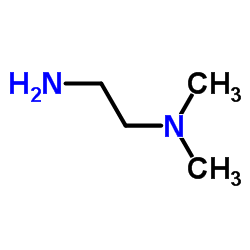1H-Benz[de]isoquinoline-1,3(2H)-dione,2-[2-(dimethylamino)ethyl]-5-nitro-
Modify Date: 2024-01-13 15:53:07
![1H-Benz[de]isoquinoline-1,3(2H)-dione,2-[2-(dimethylamino)ethyl]-5-nitro- Structure](https://image.chemsrc.com/caspic/167/54824-17-8.png)
1H-Benz[de]isoquinoline-1,3(2H)-dione,2-[2-(dimethylamino)ethyl]-5-nitro- structure
|
Common Name | 1H-Benz[de]isoquinoline-1,3(2H)-dione,2-[2-(dimethylamino)ethyl]-5-nitro- | ||
|---|---|---|---|---|
| CAS Number | 54824-17-8 | Molecular Weight | 313.30800 | |
| Density | 1.384g/cm3 | Boiling Point | 496.8ºC at 760 mmHg | |
| Molecular Formula | C16H15N3O4 | Melting Point | N/A | |
| MSDS | N/A | Flash Point | 254.3ºC | |
Use of 1H-Benz[de]isoquinoline-1,3(2H)-dione,2-[2-(dimethylamino)ethyl]-5-nitro-Mitonafide (NSC 300288) is a cytostatic agent. Mitonafide binds to double-stranded DNA through intercalation, and inhibits DNA and RNA synthesis. Mitonafide is an antitumor agent that can be used in the research of cancers, such as non-small cell lung cancer (NSCLC), leukemia[1][2][3]. |
| Name | 2-[2-(dimethylamino)ethyl]-5-nitrobenzo[de]isoquinoline-1,3-dione |
|---|---|
| Synonym | More Synonyms |
| Description | Mitonafide (NSC 300288) is a cytostatic agent. Mitonafide binds to double-stranded DNA through intercalation, and inhibits DNA and RNA synthesis. Mitonafide is an antitumor agent that can be used in the research of cancers, such as non-small cell lung cancer (NSCLC), leukemia[1][2][3]. |
|---|---|
| Related Catalog | |
| Target |
DNA and RNA synthesis[1] |
| In Vitro | Mitonafide inhibits DNA and RNA synthesis and induces single-strand breaks in the DNA of chinese hamster ovary cells[1]. The incubation of Mitonafide with rat liver microsomes and NADPH under anaerobic conditions results in the formation of a metabolite identified as 5-aminomitonafide[2]. Mitonafide (25, 50 μM, 1 h) induces single-stand breaks in the DNA of L1210 cells[2]. Mitonafide (10-100 μM) exhibits cytotoxic effect in the HOP-62 lung cell line[4]. Cell Viability Assay[6] Cell Line: SK-OV-3, HepG2, A-549, T-24, SMMC-7721, HL-7702 Concentration: 0-100 μM respectively. Incubation Time: 48 h Result: Inhibited cell viability with IC50 values of 6.26, 10.88, 7.94, 5.01, 6.94, 8.51 μM. |
| In Vivo | Mitonafide (0.5 and 1 mg/kg, i.p., 1-7 days) shows antitumoral potency in S-180 bearing mice[4]. Mitonafide (5 mg/kg, i.p., twice a day) shows anticancer activity in HepG2 xenograft model[6]. Mitonafide (single i.p. injection, S-180 bearing mice) shows the LD50 value of 10.0 mg/kg[5]. Animal Model: S-180 bearing mice[4] Dosage: 0.5 mg/kg and 1 mg/kg Administration: Intraperitoneal injection (i.p.) for 1-7 days Result: Increased in median survival times. Animal Model: HepG2 xenograft model [6] Dosage: 5 mg/kg Administration: Intraperitoneal injection (i.p.), twice a day. Result: Exhibited a relative tumor increment rates (T/C) value of 28.8%. |
| References |
| Density | 1.384g/cm3 |
|---|---|
| Boiling Point | 496.8ºC at 760 mmHg |
| Molecular Formula | C16H15N3O4 |
| Molecular Weight | 313.30800 |
| Flash Point | 254.3ºC |
| Exact Mass | 313.10600 |
| PSA | 88.13000 |
| LogP | 1.94570 |
| Index of Refraction | 1.667 |
| Storage condition | 2-8°C |
CHEMICAL IDENTIFICATION
HEALTH HAZARD DATAACUTE TOXICITY DATA
MUTATION DATA
|
| HS Code | 2933990090 |
|---|
| HS Code | 2933990090 |
|---|---|
| Summary | 2933990090. heterocyclic compounds with nitrogen hetero-atom(s) only. VAT:17.0%. Tax rebate rate:13.0%. . MFN tariff:6.5%. General tariff:20.0% |
| 2-(2-(dimethylamino)ethyl)-3-nitro-1H-benzo[de]isoquinoline-1,3(2H)-dione |
| Mitonafidum [INN-Latin] |
| Mitonafida [INN-Spanish] |
| M 4212 (Pharmaceutical) |
| 2-(2-(dimethylamino) ethyl)-5-nitro-1H-benzo[de]isoquinoline-1,3(2H)-dione |
| N-(2-(Dimethylamino)ethyl)-3-nitronaphthalimide |
| M-4212 |
| 2-(2-dimethylaminoethyl)-5-nitrobenzo[de]isoquinoline-1,3-dione |
| Mitonafide |
![5-Nitro-1H,3H-benzo[de]isochromene-1,3-dione Structure](https://image.chemsrc.com/caspic/204/3027-38-1.png) CAS#:3027-38-1
CAS#:3027-38-1 CAS#:108-00-9
CAS#:108-00-9 CAS#:69408-81-7
CAS#:69408-81-7![N-[2-(Dimethylamino)ethyl]-3-(acetylamino)-1,8-naphthalenedicarbimide structure](https://image.chemsrc.com/caspic/485/69409-02-5.png) CAS#:69409-02-5
CAS#:69409-02-5 CAS#:79070-66-9
CAS#:79070-66-9